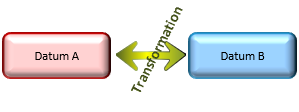3. Transformation
A transformation is used when there is no rigorous mathematical connection beteween the two systems. This happens when the position change behavior between the two systems is not systematic. A mathematical model is used to approximate the behavior. The model may be simple or complex and may emphasize specific characteristics over others. For example, a conformal transformation maintains angular relationships between lines to the detriment of line lengths.
A transformed position will have error in the resultant coordinates. The degree of error is a function of the model used, how large an area it covers, and where the positions are located.
Recall from XII. Geodesy Chapter G. The North American Datum that positional shifts from NAD27 to NAD83 were not uniform in behavior or magnitiude. This was due to a new ellipsoid that was fit differently and a readjustment that included 10 times as many control proints.
A major concern with NAD83 adoption was how to migrate positions from NAD27. The lack of an exact mathematical connection between datums meant migrated positions would be subject to error. Subsequent readjustments of NAD83 incorporated new control points with more measurements and removal of lower quality legacy measurements. While not as dramatic as those of NAD27 to NAD83, position differences were not systematic between datums. A datum-to-datum position change requires a transformataion, Figure N-3.
 |
| Figure N-3 Datum-to-Datum |
Transformations are not limited to datum-to-datum applications. A project-based coordinate system may require a transformation to connect to a UTM or SPC grid. Coordinates measured on an aerial photograph generally need to be transformed into a ground or grid system. Unless the source system is directly connected to the final system at the onset, moving coordinates from one to the other will involve a transfomation.
Common 2D transformations are discussed in Topic IX. COGO Chapter J. Coordinate Transforamtion.